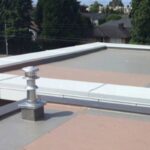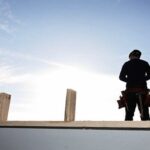When you start searching for the best flat roofing material, you’ll likely come across EPDM, also known as rubber roofing. It’s one of the most commonly recommended roofing materials by contractors and users online. But is it always the right choice for your flat roof? Or are there better alternatives?
In this post, we’ll dive into the pros and cons of EPDM roofing, and then take a look at five solid alternatives that you should consider for your next roofing project.
What is EPDM Roofing?
EPDM stands for Ethylene Propylene Diene Monomer. It’s made from recycled rubber, slate dust, and sawdust, making it eco-friendly and recyclable. It’s rolled out like a sheet, installed flat, and often glued or fastened to the roof deck. EPDM is popular because it’s affordable, durable, and easy to repair.
Advantages of EPDM Rubber Roofing
Let’s look at the top reasons why so many people go for EPDM rubber roofing:
| Advantage | Details |
|---|---|
| Affordable | Costs around $0.80 per sq. ft. – one of the cheapest roofing options available. |
| Durable | Resists weather, moisture, and contaminants. Repairs are quick with latex tape or sealant. |
| Lightweight | Doesn’t require structural reinforcements. Ideal for older buildings. |
| Easy to Install | Can even be a DIY project for small spaces. |
| Long Lifespan | Lasts 20–30 years with minimal maintenance. |
| UV Resistant | Blocks harmful sun rays and works well in both hot and cold weather. |
Disadvantages of EPDM Roofing
Despite its benefits, EPDM has a few downsides you should be aware of:
| Disadvantage | Details |
|---|---|
| Not Aesthetic | Usually only available in black and has a dull tire-like appearance. |
| Heat Absorption | Black surfaces attract heat, which can raise indoor temperatures. |
| Puncture Risk | Sharp tools or falling branches can damage the rubber easily. |
| Limited Color Options | Lighter colors are available but cost 30% more. |
| Surface Damage | Ladder use or heavy foot traffic can cause punctures. |
5 Best Alternatives to EPDM Rubber Roofing
If EPDM isn’t the right fit for your property, here are some flat roofing materials that offer great performance and aesthetics:
1. TPO (Thermoplastic Polyolefin)
TPO is like the next-gen version of EPDM. It’s also flexible and energy-efficient but more reinforced and durable. It’s made with fiberglass, talc, and carbon filler, giving it added strength.
| Feature | Details |
|---|---|
| Lifespan | 20–30 years |
| Cost | $5–$6 per sq. ft. |
| Colors | Wide range available |
| Perk | Reflects UV rays and has hot-air welded seams for better waterproofing |
TPO is great for both performance and aesthetics but comes at a higher price point.
2. PVC (Polyvinyl Chloride)
PVC is another synthetic roofing option that is incredibly durable. It can support heavy loads like HVAC units, and it’s resistant to fire and chemicals.
| Feature | Details |
|---|---|
| Lifespan | 20–30 years |
| Cost | $6–$9.50 per sq. ft. |
| Strength | Supports 350+ lbs per inch |
| Colors | Multiple, including white for reflectivity |
It’s a great choice for commercial buildings with equipment on the roof.
3. Asphalt Roofing
Asphalt has been used for decades. It’s a proven, long-lasting material with great weather resistance.
| Feature | Details |
|---|---|
| Lifespan | Up to 50 years |
| Cost | $2.50–$4 per sq. ft. |
| Benefit | Malleable and easy to repair |
| Note | Requires reinforced support due to its weight |
Though asphalt is cheaper than synthetic materials, labor costs may increase the total expense.
4. Modified Bitumen
This material is made by layering fiberglass, polyester, and asphalt. It’s tough and highly resistant to wear and tear.
| Feature | Details |
|---|---|
| Lifespan | 20–30 years |
| Cost | $4.40–$5.55 per sq. ft. |
| Perk | Tear-resistant and good for foot traffic |
| Requirement | Needs expert installation for best results |
Modified bitumen is a strong option for both residential and commercial roofs.
5. Tar & Gravel
Also known as built-up roofing (BUR), this traditional system uses hot tar and gravel for layering waterproof protection.
| Feature | Details |
|---|---|
| Lifespan | 20–25 years |
| Cost | $4–$4.72 per sq. ft. |
| Benefits | UV reflective, durable, and weatherproof |
| Drawback | Difficult to inspect for cracks due to gravel layer |
This system needs trained installers and regular inspections, but it’s tough and long-lasting.
Final Thoughts
Hello friends, rubber roofing (EPDM) can be a great option for flat roofs. It’s affordable, lightweight, and does a decent job with energy efficiency and waterproofing. But like any material, it comes with trade-offs—especially when it comes to appearance and puncture risks.
If you’re concerned about those drawbacks, there are several great alternatives like TPO, PVC, asphalt, modified bitumen, and tar & gravel, each with its own set of benefits.
Here’s a quick comparison to help:
| Material | Cost (sq. ft.) | Lifespan | Aesthetic Options | Durability |
|---|---|---|---|---|
| EPDM | $0.80–$1.50 | 20–30 years | Limited (mostly black) | Moderate |
| TPO | $5–$6 | 20–30 years | Excellent | High |
| PVC | $6–$9.50 | 20–30 years | Excellent | Very High |
| Asphalt | $2.50–$4 | Up to 50 yrs | Average | High |
| Mod. Bitumen | $4.40–$5.55 | 20–30 years | Moderate | High |
| Tar & Gravel | $4–$4.72 | 20–25 years | Low | High |
The best material depends on your budget, property design, climate, and how much foot traffic your roof gets.
Before you decide, always consult a trusted roofing professional to assess your property and guide you toward the right choice.



